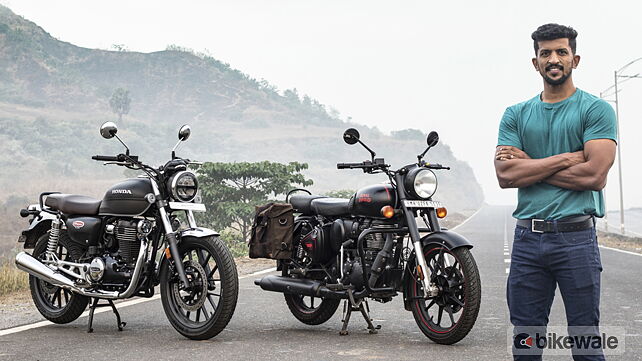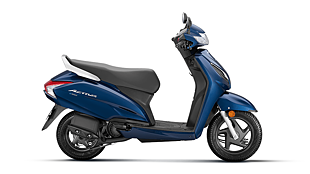Introduction

2020 has almost come to end and it has not been a good year for the world. The pandemic, the multiple lockdowns and job losses have made it difficult for everyone to survive. But now that we are about to enter 2021, we decided to do a comparison test which is probably the most sought after one in 2020.
The Royal Enfield Classic 350 – the most researched bike on BikeWale for many years has finally got a rival – the Honda CB350. So it was obvious we take both the bikes out and test every single parameter. And after spending close to 3 days with both the bikes and rating them out of 100 points, we have a clear winner. But let’s get to the parameters first.
Looks & Styling

The Classic 350 isn’t meant to be flashy or win a beauty contest. The design dates back to the 1960s with its circular headlamp, big and bulky fuel tank and curvy mudguards. There’s chrome on the long exhaust, headlamp cover, rear suspension springs and the steel rims. The company has managed to keep its retro design intact and that attracts a lot of buyers.
The CB350 on the other hand has managed to bring the best of both worlds. The design lines are simple. There's a large fuel tank that gives out a retro look and there's also lots of chrome used. But along with all these, Honda has given the bike lots of modern bits like LED lights and alloy wheels. This design language has finally managed to turn heads every single time - something that was usually happening only with the Classic 350.
Ergonomics & Quality

The CB350 and the Classic 350 are a part of a segment where most of the riders want comfort for city as well as highway use. And fortunately, both the bikes meet this requirement quite easily. Both the bikes get center-set footpegs, upright handlebar and seats that offer decent amount of space. As a result, the seating triangle is extremely comfortable with no signs of cramped space.
When it comes to quality, the CB350 takes the award here. Being the only modern bike in this test, the CB350 comes with quality and finesse that isn’t seen on the Classic 350. The plastics and metals used, the chassis welds and even the quality of seat is much better than the Classic 350.
Features & Technology

The CB350 is loaded with some neat features. In fact, it also gets the first-in-class traction control system. The bike also gets Bluetooth-enabled instrument cluster that can be connected to the smartphone via an app. The dual-channel ABS is standard. It also gets other things like full LED lights, hazard lamp and a neatly designed switchgear.
The Classic 350 falls way behind the CB350 when it comes to features. There is no fancy equipment, nor are there features that are outstanding on the Classic. The instrument cluster is analogue and suspension is telescopic at the front with twin gas charged shock absorbers at the rear. The only latest tech we can think of is the presence of dual-channel ABS and fuel-injection.
Engine & Gearbox

The 349cc single-cylinder air-cooled engine on this bike is brand new. It has been co-developed with Honda Japan. So we should expect extreme levels of refinement, right? We’ll get to that in a bit. Let’s talk numbers first. This engine displaces 349cc and it makes around 21bhp at 5500rpm and peak torque of 30Nm at 3000rpm. This motor is mated to five-speed gearbox that transfers power to the rear wheel via a chain drive.
The Classic 350 gets its power from a 346cc single-cylinder air-cooled motor. This mill is all about low-end and mid-range torque. It makes 19.1bhp and peak torque of 28Nm at 4000rpm. This BS6 engine has lesser vibrations compared to what we used to see in its older iterations. There's also good amount of refinement now, but it continues to lack the performance, blame the poor power-to-weight ratio. The five-speed gearbox on the other hand, has improved considerably and the shifts are much nicer now.
Performance

The CB350 doesn’t have a lot of torque in the low revs. In fact, the CB350 gains some excitement only at higher revs and that is something we didn’t enjoy much. Lack of torque at low revs mean you have to plan overtakes every single time – be it in the city or on the highway. Plus, you need to shift gears quite a few times and that increases some fatigue. I mean I know that the gear shifts are smooth, but your leg still has some work to do. But the clutch pull is extremely smooth and light. Something that will make riding in the city extremely comfortable.
The Classic 350 was always known for oodles of low-end torque and with the BS6 model, things are no different. As soon as you twist that throttle, the bike goes off the line easily. The mid-range too is likeable and can be enjoyed on a daily basis. But as the revs starts to climb, there are some vibrations that creep in on the handlebar, footpegs and even the seat. So it is better to stay around the 80kmph mark throughout. As a result, the comfortable cruising speed is less as compared to the CB350.
Ride Quality, Handling & Braking

Out of both the bikes, the Classic 350 has a better low speed ride, whereas the CB350 is good when ridden fast over bad roads. So in that sense, both the bikes are almost in line with each other when it comes to overall ride quality. But the extra spring setup on the Classic 350 aids the city riding experience. But if you are on the heavier side, you’ll end up sliding to the extreme rear-end of the seat.
When it comes to handling, be it in the city or the highway, the CB350 takes most of the points here, thanks to its light kerb weight and extremely good weight balance. The Classic 350 on the other hand takes some effort to live with on a daily basis. Being an old platform, most of the cycle parts are on the heavier side and that affects the overall riding experience. It’s the same story with the brakes. The Classic 350 system works fine, but would have liked to have more power and feel. The CB350 being a modern bike gets a good braking system and it works fairly well all the time.
Fuel Efficiency

The CB350 returned us 32kmpl. So with a fuel tank capacity of 15-litres, you are looking at a riding range of approximately 450kms. The Classic 350 isn’t too far with 30kmpl.
Price & Warranty

The Honda CB350 is the more expensive one here. With a price tag of Rs 2.19 lakh on-road Mumbai, it is Rs 18,000 more than the Classic 350. When it comes to warranty, Honda is offering a standard package of three years with the CB350, with an option to extend for three more. So that’s six years of warranty for the CB350. The Classic 350 comes with a two year warranty that can be extended up to four years.
Desirability

It is clear from the past sales figure and research trend that the Royal Enfield Classic 350 is the most desirable motorcycle in India. Its modern retro styling, the exhaust thump, the bulky body proportions and the access to a lifestyle brand like Royal Enfield has made it reach this stage. Plus, the rider gets access to a whole new level of accessories, clothing and community like Rider Mania.
Verdict

The 100 point rating system clearly says that the brand new Honda CB350 is the winner of this much awaited comparison test and honestly, we aren’t surprised at all. Honda with the CB350 has got a lot of things right- something that is much needed in this segment. The bike has a great aspirational styling. It is loaded with modern styling. It also rides and handles pretty well. Plus, being a Japanese brand, there’s a trust aspect attached to it. The Classic 350 on the other hand, has an extremely strong brand recall and value. But the bike feels old. It is heavy. It doesn’t handle that well and it can’t handle a comfortable cruising speed of 100kmph.
Photography by Kapil Angane
Final Scores

Gallery
1/17
Honda Hness CB350 Right Side View
Double Tap to Zoom
























![Honda Hness CB350 [2020-2022] Image Honda Hness CB350 [2020-2022] Image](https://imgd.aeplcdn.com/272x153/bw/models/honda-hness-cb350-dlx20201113120847.jpg?q=80)























![KTM 390 Adventure X [2025] KTM 390 Adventure X [2025]](https://imgd.aeplcdn.com/272x153/n/cw/ec/190885/390-adventure-x-2025-right-side-view.jpeg?isig=0&q=80)